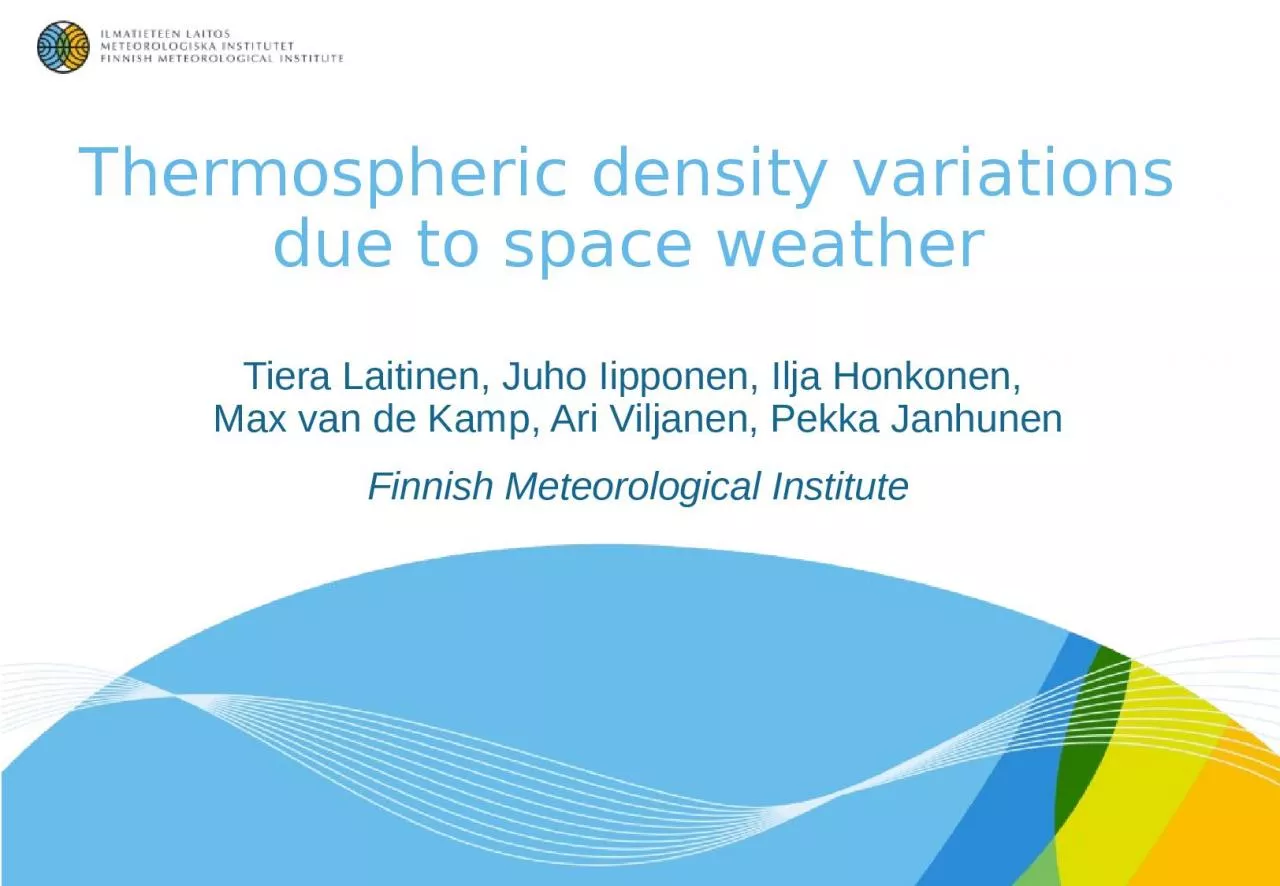

variations due to space weather Tiera Laitinen Juho Iipponen Ilja Honkonen Max van de Kamp Ari Viljanen Pekka Janhunen Finnish Meteorological Institute Realtime space ID: 1022033
Download Presentation The PPT/PDF document "Thermospheric density" is the property of its rightful owner. Permission is granted to download and print the materials on this web site for personal, non-commercial use only, and to display it on your personal computer provided you do not modify the materials and that you retain all copyright notices contained in the materials. By downloading content from our website, you accept the terms of this agreement.
1. Thermospheric density variations due to space weatherTiera Laitinen, Juho Iipponen, Ilja Honkonen, Max van de Kamp, Ari Viljanen, Pekka JanhunenFinnish Meteorological Institute
2. Real-time space weather modellingusing the GUMICS global MHD simulation.How space weather expedited GOCE decayModerate geomagnetic disturbances expedited re-entry by several hours.Changes in decay rate agree with GUMICS simulation.Correlations of magnetic indices with GOCE+ densityTime integration of indices enhances results.An empirical proxy correction to NRLMSISE-00 model is being developed.Outline
3. Real-time space weather modelling
4. Global magnetosphere-ionosphere coupling simulation modelThe only one of its kind in EuropeDeveloped at FMI since 1993Dozens of scientific publicationsMHD magnetosphereElectrostatic ionosphereGUMICS
5. GUMICS: M-I-couplingSolar windJ‖e– prec.ΦMapped alongdipole field lines:B, n, T, v, …Φ, Σ, J, E, e– prec., …
6. A new parallel version of the codeCurrently under validation and finalisation.Capable of faster than real time runningwith moderate resolution, ~ 0.5 - 1 RErequires ~ 100 cores.First technical real time operations test was performed during the GOCE caseGUMICS-5
7. Chained run systemSolar wind propagation from L1 takes ~ 1 h.Allows ~ 20 min prediction time.Initial state from the previous runLatest solar wind from ACERun extended beyondmeasured solar wind with constant inputNew run every 20 min
8. GUMICS resultsReal-time simulations were done with GUMICS-5.Later the period was simulated with GUMICS-4with better resolution.Joule heating +electron precipitation.Integral over 24 h(heat accumulation).
9. From Joule heating to air drag
10. A simple model for heat depositionHeight [km]Extra heatfrom SWETemperaturechangeQuiet time atmospheric profiles from NRLMSISE-00JH from GUMICSAssume globally even heat distributionAd hoc heating profile with maximum at 120 km
11. Density increases above ~130 kmAtmospheric profileswithout and withionospheric heating.We estimated ~15 %increase at GOCE’s altitude on 30 Oct.PressureDensityTemperatureHeight [km]Height [km]Height [km]
12. Extracting changes in decay rateNominal decay rate in a time-invariant atmosphereReal decay rateSpace weather effect?Decay rate[km/orbit]Nominal density at orbit from NRLMSISE-00Fit to the real decay rate (get air drag coefficient)Fitted density is the nominal decay rateCalculate difference of real and nominal decay rate
13. Simulation predicts orbit variations
14. Global MHD simulation predicted variations in GOCE decay rate due to space weather.Effect on decay rate about 15 %, with only moderate SWe disturbances, no geomagnetic storms.SWe on 30 Nov. expedited GOCE decay by about 6 h.7 Nov. another SWe event of similar magnitude.This analysis was done afterwards, but the procedure could be implemented as a forecast routine (with forecast time ~ 20 min).Conclusions on simulations
15. Results from GOCE+ atmospheric density data
16. The decay period exercise incited us to analyse GOCE+ density data from the entire mission.First analysis concentrated on geomagnetic storms with max(AE) > 1000. We identified e.g. TADs and analysed the travel time of disturbances from polar to equatorial region.We found good correlation between magnetic indices and density variations.Currently we are developing an empirical model that corrects NRLMSISE-00 density for geomagnetic activity using AE index.Analysing GOCE+ density
17. Time integration enhances AE index usabilityGOCE+ density vs. momentary AEGOCE+ densityvs. AE time integral
18. Best integral window?AEIMF |B|Window size (h)Max AE
19. MomentaryAvg. int. w. Best int. w.Int. w. lengthAE0,55 (15)0,83 (12)0,84 (11)21 (12) hap0,54 (18)0,85 (11)0,86 (9)26 (12) h|B|0,54 (24)0,66 (26)0,76 (21)37 (19) hε0,27 (15)0,58 (30)0,70 (23)34 (18) hCorrelations for proxiesAE and ap are equally good proxies.|B| is the best solar wind proxy.Solar wind proxies require longer integration than magnetic indices.Possibility to shorten the integration window from end to increase forecast lead time?
20. Density from GOCE+, MSIS and AE proxyTimeGm. latitudeGOCE+AE proxyMSISAn emperical model based on AE and MSIS is being developed.MSIS underestimates density during geomagnetic storms especially at mid-latitudes.
21. MSIS and AE proxy model performance comparisonGOCE+ vs. MSISrelative differenceGOCE+ vs. AE proxyrelative differenceAE increases
22. Using AE index based correction significantly enhances thermosphere model agreement with observations.Thermospheric density correlates best with a time integral over ~24 h of AE or ap index.AE is available in real time.Atmospheric heating could also be derived from a global MHD simulation, as demonstrated by our modelling of GOCE decay.Could be used for prediction.Solar wind data availability limits prediction lead time.Conclusions
23. Tiera.Laitinen@fmi.fi